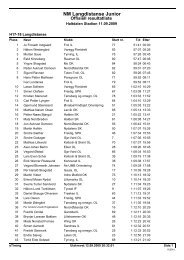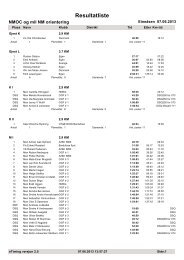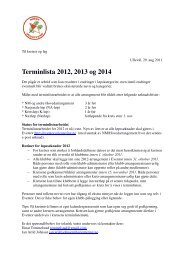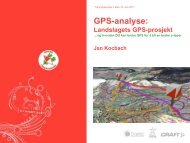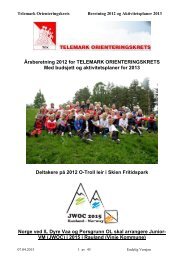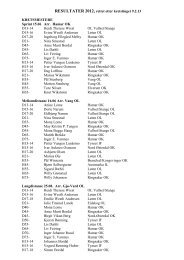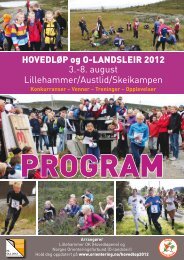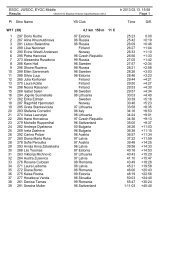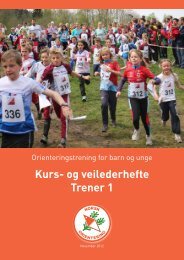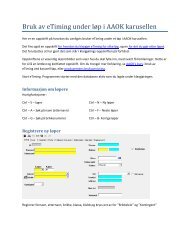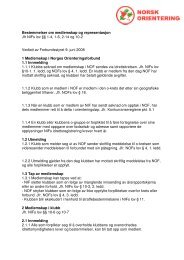Rules for the Orienteering event in - International Orienteering ...
Rules for the Orienteering event in - International Orienteering ...
Rules for the Orienteering event in - International Orienteering ...
Create successful ePaper yourself
Turn your PDF publications into a flip-book with our unique Google optimized e-Paper software.
should preferably make runners pass <strong>the</strong> Arena dur<strong>in</strong>g <strong>the</strong> competition. The demand onselection of Arena is subsequently high, provid<strong>in</strong>g both suitable terra<strong>in</strong> and goodpossibilities to make runners visible to spectators. Spectators are not allowed along <strong>the</strong>course except <strong>for</strong> parts pass<strong>in</strong>g <strong>the</strong> Arena (<strong>in</strong>clud<strong>in</strong>g controls at <strong>the</strong> Arena).2.3 The mapThe standard ISOM specification shall be followed. The map scale is 1:10 000. Theterra<strong>in</strong> shall be mapped <strong>for</strong> 1:15 000 and <strong>the</strong>n be strictly enlarged as specified by ISOM.2.4 W<strong>in</strong>n<strong>in</strong>g time, start <strong>in</strong>terval and tim<strong>in</strong>gThe w<strong>in</strong>n<strong>in</strong>g time, <strong>for</strong> both women and men, shall be 30 – 35 m<strong>in</strong>utes. In WOC andWorld Cup <strong>the</strong> w<strong>in</strong>n<strong>in</strong>g time <strong>in</strong> qualification races shall be 25 m<strong>in</strong>utes. The start <strong>in</strong>tervalis 2 m<strong>in</strong>utes and a time-trial, <strong>in</strong>dividual <strong>for</strong>mat is used. The competitor shall have passed<strong>the</strong> start gate be<strong>for</strong>e hav<strong>in</strong>g access to <strong>the</strong> map.3 LONG DISTANCE3.1 The profileThe Long distance profile is physical endurance. It takes place <strong>in</strong> a non-urban (mostly<strong>for</strong>ested) environment, and aims at test<strong>in</strong>g <strong>the</strong> athletes’ ability to make efficient routechoices, to read and <strong>in</strong>terpret <strong>the</strong> map and plan <strong>the</strong> race <strong>for</strong> endurance dur<strong>in</strong>g a long andphysically demand<strong>in</strong>g exercise. The <strong>for</strong>mat emphasises route choices and navigation <strong>in</strong>rough, demand<strong>in</strong>g terra<strong>in</strong>, preferably hilly. The control is <strong>the</strong> end-po<strong>in</strong>t of a long leg withdemand<strong>in</strong>g route choice, and is not necessarily <strong>in</strong> itself difficult to f<strong>in</strong>d. The Longdistance may <strong>in</strong> parts <strong>in</strong>clude elements characteristic of <strong>the</strong> Middle distance with <strong>the</strong>course suddenly break<strong>in</strong>g <strong>the</strong> pattern of route choice orienteer<strong>in</strong>g to <strong>in</strong>troduce a sectionwith more technically demand<strong>in</strong>g legs.3.2 Course plann<strong>in</strong>g considerationsThe course should be set to allow competitors to be seen by spectators dur<strong>in</strong>g <strong>the</strong> courseof <strong>the</strong> race as well as when f<strong>in</strong>ish<strong>in</strong>g. Preferably, <strong>the</strong> start should be at <strong>the</strong> Arena and <strong>the</strong>course should make runners pass <strong>the</strong> Arena dur<strong>in</strong>g <strong>the</strong> competition. A special element of<strong>the</strong> Long distance is <strong>the</strong> long legs, considerably longer than <strong>the</strong> average leg length. Theselonger legs may be from 1.5 to 3.5 km depend<strong>in</strong>g on <strong>the</strong> terra<strong>in</strong> type. Two or more suchlong legs should <strong>for</strong>m part of <strong>the</strong> course (still requir<strong>in</strong>g full concentration on map read<strong>in</strong>galong <strong>the</strong> route chosen). Ano<strong>the</strong>r important element of <strong>the</strong> Long distance is to use coursesett<strong>in</strong>gtechniques to break up groups of runners. Butterfly loops are one such technique.The terra<strong>in</strong> itself should be used as a break-up method by putt<strong>in</strong>g <strong>the</strong> course through areaswith limited visibility. Spectators are not allowed along <strong>the</strong> course except <strong>for</strong> partspass<strong>in</strong>g <strong>the</strong> Arena (<strong>in</strong>clud<strong>in</strong>g controls at <strong>the</strong> Arena).3.3 The mapThe standard ISOM specification shall be followed. The map scale is 1:15 000.3.4 W<strong>in</strong>n<strong>in</strong>g time, start <strong>in</strong>terval and tim<strong>in</strong>gThe w<strong>in</strong>n<strong>in</strong>g time shall be 70 – 80 m<strong>in</strong>utes <strong>for</strong> women and 90 – 100 m<strong>in</strong>utes <strong>for</strong> men. InWOC and World Cup <strong>the</strong> w<strong>in</strong>n<strong>in</strong>g times <strong>in</strong> qualification races shall be 45 m<strong>in</strong>utes <strong>for</strong>women and 60 m<strong>in</strong>utes <strong>for</strong> men. The start <strong>in</strong>terval is 3 m<strong>in</strong>utes. A time-trial, <strong>in</strong>dividual<strong>for</strong>mat is used. The competitor shall have passed <strong>the</strong> start gate be<strong>for</strong>e hav<strong>in</strong>g access to <strong>the</strong>map.4 RELAY4.1 The profileThe Relay profile is team competition. It takes place <strong>in</strong> a non-urban (mostly <strong>for</strong>ested)environment. The <strong>for</strong>mat is built on a technically demand<strong>in</strong>g concept, more similar to <strong>the</strong>concept of <strong>the</strong> Middle than <strong>the</strong> Long distance. Some elements characteristic of <strong>the</strong> Longdistance, like longer, route-choice legs should occur, allow<strong>in</strong>g competitors to pass eachPage 40 IOF Foot <strong>Orienteer<strong>in</strong>g</strong> Competition <strong>Rules</strong> 2013




